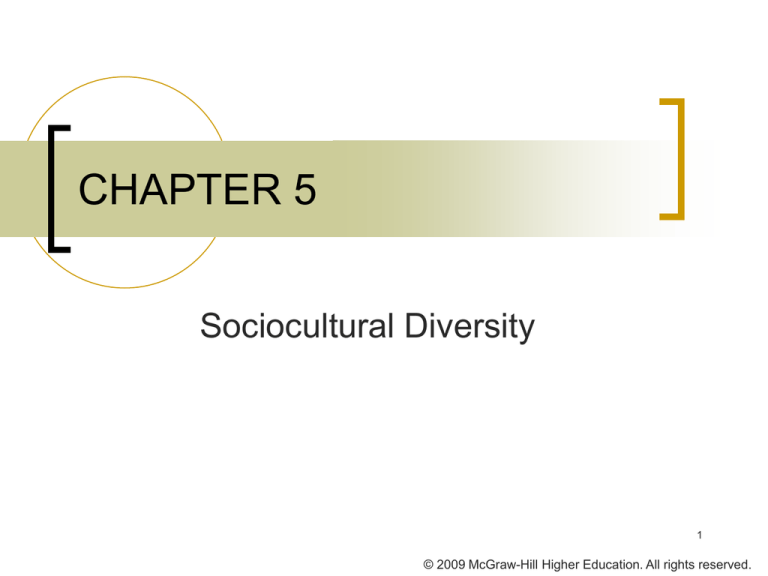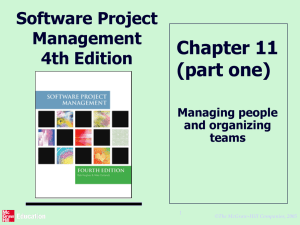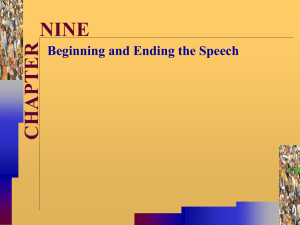
CHAPTER 5
Sociocultural Diversity
1
© 2009 McGraw-Hill Higher Education. All rights reserved.
Learning Goals
1. Discuss how variations in culture,
socioeconomic status, and ethnic
background need to be taken into account
in educating children.
2. Describe some ways to promote
multicultural education.
3. Explain the various facets of gender,
including similarities and differences in
boys and girls; discuss gender issues in
teaching.
© 2009 McGraw-Hill Higher Education. All rights reserved.
Sociocultural Diversity
Culture and
Ethnicity
Culture
Socioeconomic
Status
Bilingualism
Ethnicity
© 2009 McGraw-Hill Higher Education. All rights reserved.
Culture
Culture refers to the behavior patterns, beliefs, and
all other products of a particular group of people
that are passed on from generation to generation.
Cross-Cultural Studies
Provide information about the degree
to which people are similar
Elucidate behaviors specific to certain
cultures
© 2009 McGraw-Hill Higher Education. All rights reserved.
Individualism vs. Collectivism
Collectivism
Individualism
Gives priority to
personal goals
Values feeling good
and personal
distinction
Fosters
independence
Values group;
personal goals are
subordinated
Encourages
interdependence of
group members
Supports
harmonious
relationships
© 2009 McGraw-Hill Higher Education. All rights reserved.
Socioeconomic Status
Socioeconomic status (SES): The grouping of people
according to their economic, educational, and
occupational characteristics.
Educating students from low-SES backgrounds
requires strategies that address issues such as
discipline, motivation, parent involvement,
mentoring, and the untapped knowledge these
students can access.
© 2009 McGraw-Hill Higher Education. All rights reserved.
Children in Poverty
Of the 17.4% of U.S. children
who live in poverty:
50% live in African American households
40% live in Latino households
© 2009 McGraw-Hill Higher Education. All rights reserved.
Negative Impact of Poverty on
Children and Schools
Poor Schools
Poor Students
• Have fewer resources
• Old, poorly maintained
buildings
• Less experienced
teachers
• Encourage more rote
learning
• Provide environments not
conducive to learning
• Greater adversity at
home & school
• Less cognitively
stimulating home
environments
• Lower achievement
scores
• Lower graduation rates
• Lower % college bound
© 2009 McGraw-Hill Higher Education. All rights reserved.
Ethnicity
Ethnicity refers to a shared pattern
of characteristics such as cultural
heritage, nationality, race, religion,
and language.
For children of color, educational
segregation is still a reality that
affects the school experience.
© 2009 McGraw-Hill Higher Education. All rights reserved.
Prejudice
An unjustified negative attitude
toward an individual because of
his/her membership in a group.
© 2009 McGraw-Hill Higher Education. All rights reserved.
English as a Second
Language
English immersion
Transitional bilingual
Two-way or dual bilingual education
© 2009 McGraw-Hill Higher Education. All rights reserved.
Sociocultural Diversity
Multicultural
Education
Improving
Relationships
Among Children
from Different
Ethnic Groups
Empowering
Students
Culturally
Relevant
Teaching
IssuesCentered
Education
© 2009 McGraw-Hill Higher Education. All rights reserved.
The Multicultural Classroom
• High expectations for ALL students
• Curriculum presents diverse cultural
perspectives
• Instructional materials represent diverse
backgrounds and experiences
• Hidden curriculum reflects positive
aspects of diversity
• Counseling program challenges students
to dream and reach those dreams
© 2009 McGraw-Hill Higher Education. All rights reserved.
Empowering Students
Curriculum should be antiracist and
anti-discriminatory.
Multicultural education should be
ubiquitous.
All students should be culturally
conscious.
© 2009 McGraw-Hill Higher Education. All rights reserved.
Improving Relations Among Children
from Different Ethnic Groups
The Jigsaw classroom
Positive personal contact with others from
different cultural backgrounds
Perspective taking
Critical thinking and emotional intelligence
Reducing bias
Increasing tolerance
School and community as a team
© 2009 McGraw-Hill Higher Education. All rights reserved.
Reflection & Observation
Reflection:
What experiences have you had
with students different from
yourself?
© 2009 McGraw-Hill Higher Education. All rights reserved.
Sociocultural Diversity
Gender
Eliminating
Gender Bias
Exploring Gender
Views
Gender in
Context
Gender Stereotyping,
Similarities, and
Differences
Gender Role
Classification
© 2009 McGraw-Hill Higher Education. All rights reserved.
Gender
Gender: Sociocultural dimensions of
being female or male.
Gender roles: Social expectations
that prescribe how males and
females should think, act, and
feel.
Gender typing: Process by which
children acquire culturally
appropriate thoughts, feelings, and
behaviors.
© 2009 McGraw-Hill Higher Education. All rights reserved.
Views on Gender Development
Biological
Cognitive
Social
© 2009 McGraw-Hill Higher Education. All rights reserved.
Gender Similarities and
Differences
The brain
Physical
performance
Math and science
skills
Verbal skills
Educational
attainment
Relationship skills
Prosocial behavior
Aggression
Emotion and its
regulation
© 2009 McGraw-Hill Higher Education. All rights reserved.
Eliminating Gender Bias
Teacher-Student Interaction
Bias against boys
Bias against girls
Curriculum and Athletics Content
© 2009 McGraw-Hill Higher Education. All rights reserved.
Sexual Harassment
…is a form of power and dominance of one
person over another that can result in harmful
consequences for the victim.
Quid Pro Quo
Hostile Environment
School employee
threatens to base an
education decision
(grades) on a student’s
submission to
unwelcome sexual
conduct.
A student is subjected
to unwelcome sexual
conduct that is so severe,
persistent, and pervasive
that it limits the student’s
ability to benefit from his or
her education.
© 2009 McGraw-Hill Higher Education. All rights reserved.
Enter the Debate
Should teachers treat boys and girls differently?
YES
NO
© 2009 McGraw-Hill Higher Education. All rights reserved.
Crack the Case
These Boys
1.
2.
3.
What are the issues in this case?
Based on the ideas and information presented in
your text to this point, discuss what you believe to
be happening in this classroom and the possible
influences on Mrs. Jones’s ideas of gender. Cite
research and theories of gender development.
What influences do you believe Mrs. Jones’s
behavior will have on her students? Why?
© 2009 McGraw-Hill Higher Education. All rights reserved.
Crack the Case
These Boys
4.
5.
6.
What should Mrs. Jones do at this point? Why?
What sort of outside assistance might help her?
If you were a student teacher in this classroom,
what, if anything, would you do? Why?
What will you do in your own classroom to
minimize gender bias?
© 2009 McGraw-Hill Higher Education. All rights reserved.









